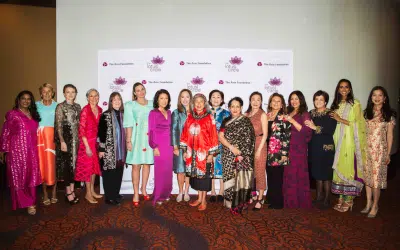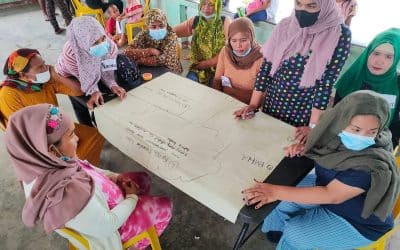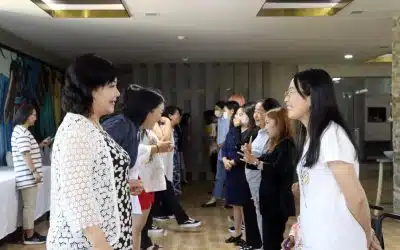InAsia
Insights and Analysis
Women Are Missing from India’s Border Trade
July 12, 2023
The cross-border trade ecosystem in India does not include enough women. Women who are a part of India’s export and import value chains are typically confined to the lower levels of production and manufacturing, and virtually excluded from higher levels of trade value chains, policymaking positions, and the executive suite. This is important because India could add US$770 billion to its GDP by 2025 just by offering equal opportunities to women.
While the issue is global, my focus here is on India, whose rapidly evolving cross-border trade ecosystem poses a unique challenge for research practitioners like me trying to understand how trade can work for all.
My observations are based on more than a decade of research, and recent visits to more than 25 ports in India—a mix of seaports, land ports, dry ports, and air cargo complexes—in the last couple of years. During these port visits, I observed that, while infrastructure and operations varied, there was one common thread: missing women.

A discussion with the trade community at Uri, in Jammu and Kashmir, where trade takes place across the Line of Control between India and Pakistan. (Photo: Nikita Singla)
The data I collected confirmed pre-pandemic estimates that the labor-force participation rate (LFPR) of women in India is among the lowest in the world: 20.3 percent in 2019, compared to 75.3 percent for men. To put this in the regional context, female LFPR is 30.5 percent in neighboring Bangladesh and 33.7 percent in Sri Lanka. The participation rate for women in trade is even lower, but uncertain because of lack of data.
In 2018, The Asia Foundation, with support from The World Bank through Australian DFAT, set out to examine women’s low rate of participation in trade in the context of the Bhutan-Bangladesh-India-Nepal (BBIN) Motor Vehicles Agreement. The 2018 report was a first step towards identifying ways in which women could get more benefit from regional trade. A 2020 joint report from the World Bank and the World Trade Organization, Women and Trade: The Role of Trade in Promoting Women’s Equality, further explored how trade has the potential to expand women’s role in the economy, decrease inequality, and expand women’s access to skills and education.
In the absence of gender-disaggregated data from individual firms, my visits to various Indian border areas provided some qualitative insights into this subject and helped better elucidate the limited presence of women in India’s cross-border trade ecosystem.
I observed that women in general are concentrated in the lower levels of trade value chains, with only a limited presence in production and manufacturing and almost none in areas such as research and development, marketing, or distribution. During a visit to Amritsar, for example, along the India-Pakistan border, I met several women who worked hand-cutting dry dates imported from Pakistan. Nearly a thousand of them scraped together a minimal livelihood from this manual labor.
Along the India-Bangladesh border, I met a woman vendor at the border haat (local market) between Srinagar (Tripura) and Chagalnaiya (Chittagong), a former housewife who now made around US$300 every Tuesday, the market’s day of operation. “Women in Bangladesh are no less competent than men,” she told me, “and it is time that they get the highest encouragement and support, not only from the government, but also from their families to get involved in business.”

A woman vendor at one of the border markets between India and Bangladesh. (Photo: Nikita Singla)
The same observation is also documented in research conducted by the World Bank Group in 2020 on the cross-border value chains for spices and agricultural products in India’s northeast. The study found that women’s participation is greater at the bottom of the value chain, in on-farm activities such as cultivation, harvesting, sorting, grading, packaging, and labeling.
On the other hand, during some of my visits, I also found evidence of some noteworthy local initiatives that reflect a commitment to make the local ecosystem more conducive to women’s participation. A small example is the sanitary napkin vending machine at the land port at Agartala, along the India-Bangladesh border, a positive sign that cross-border trade is becoming more attuned to the needs of women.
In Dawki, a newly inaugurated port along the India-Bangladesh border where women now comprise nearly 40 percent of the workforce, the port manager told me of various measures that had been taken to recruit women from the local community.

A discussion at the Dawki-Tamabil line between India and Bangladesh. (Photo: Nikita Singla)
It was through these first-hand observations that I got deeply interested in and concerned about this subject. The invitation to write the recently published policy paper Women’s Inclusion in India’s Trade Ecosystem, supported by the U.S. Embassy in India and The Asia Foundation, gave me another opportunity to dig deeper into this fundamental issue.
Based on my research and direct interactions with government officials, particularly in customs; gender experts in academia; and inclusion officers at multilateral agencies, I concluded in the paper that the trade sector in India had both progress to celebrate and further steps to take with respect to women’s inclusion.
In addition to the anecdotal evidence and research findings shared above, the 2021 UN Global Survey on Digital and Sustainable Trade Facilitation has some telling data showing that India’s implementation rate in the “women in trade facilitation” category is just 66 percent. The data covers trade policies to increase women’s participation in trade, trade facilitation measures to benefit women in trade, and women’s membership in national-level trade committees.
These numbers in no way undermine the existing efforts. For example, India’s high-level commitment to gender-inclusive trade is reflected in the government’s National Trade Facilitation Action Plan 2020–23, in which Action Point 27 is specifically aimed at promoting gender inclusion in trade.
During the Covid-19 pandemic, India also took several steps under the Turant Customs Programme to make the customs clearance process faceless, paperless, and contactless. Reforms like these reduce opportunities for bribery and corruption, which research has shown to disadvantage women-owned businesses disproportionately. Shifting from physical to digital customs procedures can level the playing field for women, if complemented by efforts to enhance women’s awareness and adoption of the new technologies.
As they say, only what gets measured gets done. To continue women’s progress in trade, policymaking needs to be supported by national data collected at the firm level, disaggregated by gender, and made readily accessible to third-party researchers.
With more and better data, policymakers can address areas such as (1) skilling, training, and mentoring of women for higher positions in trade value chains, including leadership; (2) reforming trade institutions to overcome gender financing gaps and enhance women’s participation in port-level decision-making; (3) developing high-level policies such as gender-specific provisions in new trade agreements; and (4) empowering women more generally, particularly through greater investment in the care economy and mandatory gender-tagging of all projects (see figure 1).

Figure 1: Areas of reform for women’s inclusion in India’s trade ecosystem. (Singla, 2023, Women’s Inclusion in India’s Trade Ecosystem)
Each of these reforms also has a role to play in advancing the four pillars of the Indo-Pacific Economic Framework—trade, supply chains, clean economies, and fair economies—which aim to increase resilience, sustainability, inclusion, economic growth, fairness, and competitiveness. Women’s empowerment is central to the achievement of these goals.
At present, there are 432 million women of working age in India, of which 343 million are employed in the informal sector. A report by the McKinsey Global Institute has estimated that just by offering equal opportunities to women, India could add US$770 billion to its GDP by 2025. Trade is just one sector!
Read the report Women’s Inclusion in India’s Trade Ecosystem.
Nikita Singla is associate director of the New Delhi-based Bureau of Research on Industry and Economic Fundamentals (BRIEF). She can be reached at [email protected]. The views and opinions expressed here are those of the author, not those of The Asia Foundation.
About our blog, InAsia
InAsia is posted and distributed every other Wednesday evening, Pacific Time. If you have any questions, please send an email to [email protected].
Contact
For questions about InAsia, or for our cross-post and re-use policy, please send an email to [email protected].The Asia Foundation
465 California St., 9th Floor
San Francisco, CA 94104
The Latest Across Asia
Program Snapshot
May 2, 2024
News
April 25, 2024

2024 Lotus Leadership Awards
The Lotus Leadership Awards recognize contributions towards gender equality in Asia and the Pacific







0 Comments